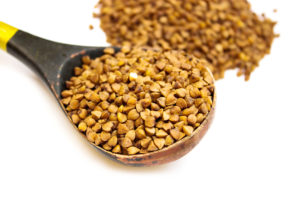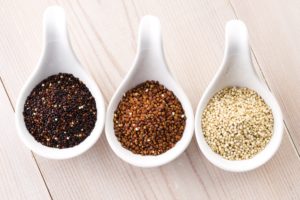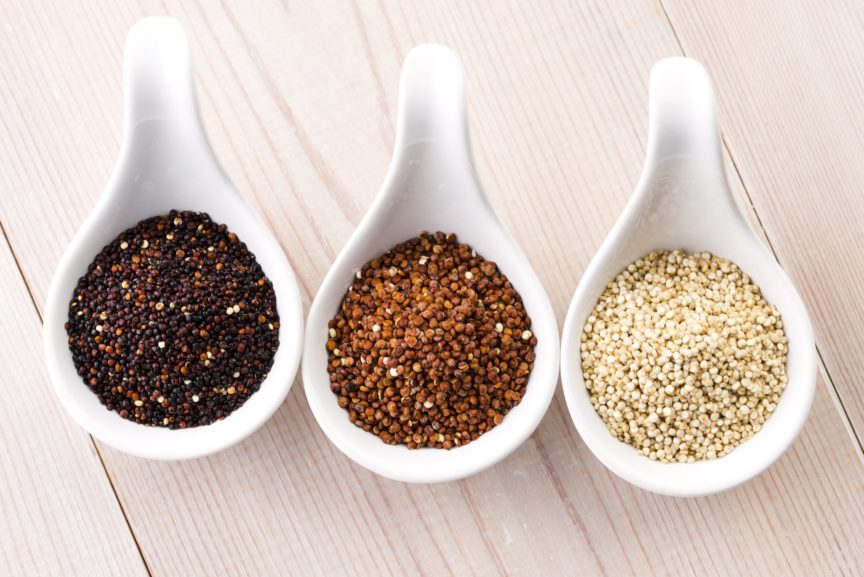 Pseudograins are seeds and grasses that commonly but mistakenly get categorized as grains.
Pseudograins are seeds and grasses that commonly but mistakenly get categorized as grains.
Marni Wasserman, writing for Chatelaine, explains, “These ‘superfood’ seeds are known to be extremely high in protein, fibre and are low-glycaemic carbohydrates. They are also bursting with vitamins and minerals like calcium, iron and magnesium. They are all gluten-free and easy to digest, absorb and assimilate. These are some pseudo grains you could add to your diet. As you will see these grain-like seeds are extremely versatile, offering an array of diverse nutrition. Many of them may be new to your pantry, but I encourage you to give one or all of them a try!”
Amaranth: The seed of a plant from Central America. It has a nutty flavour and combines well with other grains. Health benefits: Higher in protein than many other grains, it’s also high in the essential amino acid lysine, often hard to find in plant-based foods. Amaranth is a good source of calcium and iron, important for bone health as well as being high in potassium, phosphorous and Vitamins A, E and C. Finally, it’s also filled with essential oils that help lower hypertension, cholesterol and blood pressure.
 Buckwheat: A fruit seed related to rhubarb and sorrel, buckwheat is a suitable grain substitute for people who are sensitive to wheat or other grains that contain protein glutens. Health benefits: Rich in flavonoids and phytonutrients, both of which protect against disease by extending the action of vitamin C, while acting as antioxidants. Buckwheat is a great source of protein, manganese and vitamins B and E and helps to balance and lower cholesterol levels while also protecting against heart disease. Buckwheat is also claimed to have mood-enhancing and mental clarity properties.
Buckwheat: A fruit seed related to rhubarb and sorrel, buckwheat is a suitable grain substitute for people who are sensitive to wheat or other grains that contain protein glutens. Health benefits: Rich in flavonoids and phytonutrients, both of which protect against disease by extending the action of vitamin C, while acting as antioxidants. Buckwheat is a great source of protein, manganese and vitamins B and E and helps to balance and lower cholesterol levels while also protecting against heart disease. Buckwheat is also claimed to have mood-enhancing and mental clarity properties.
Quinoa: an amino acid-rich (protein) seed that has a fluffy, creamy, slightly crunchy texture and a somewhat nutty flavor when cooked. Most commonly considered a grain, quinoa is actually a relative of leafy green vegetables like spinach and Swiss chard. Health benefits: It is a complete protein, providing all essential amino acids. It’s also high in fibre, calcium and iron.
Teff: While still growing in the fields, teff appears purple, grey, red or yellowish-brown. Seeds range from dark-reddish-brown to yellowish-brown to ivory. Health benefits: Teff leads all the grains—by a wide margin—in its calcium content, with a cup of cooked teff offering 123 mg. It’s an excellent source of vitamin C, a nutrient not commonly found in grains. Teff is also high in resistant starch, a type of dietary fibre that can benefit blood-sugar management, weight control and colon health.
Wild rice: Wild rice is really an aquatic seed found mostly in the freshwater lakes of Canada, Michigan, Wisconsin and Minnesota. Cooked wild rice has a rich, nutty flavor, sometimes described as a smoky flavor, and a texture that is satisfyingly chewy. It can be as long as one-inch and the colours can vary from medium-brown to nearly pure black. Health benefits: It is a source of lysine (an essential protein) and B vitamins, has almost twice the protein content of venerable brown rice and almost six times the amount of folic acid as brown rice.
Food features and recipes like this appear in the Desang Diabetes Magazine, our free-to-receive digital journal. We cover diabetes news, diabetes ‘kit’ and information on food suitable for maintaining good blood glucose control or a diabetic diet, including a regular Making Carbs Count column. It’s free! Go to the top of this page to sign up – we just need your email address. See current and past issues at
www.desang-magazine.co.uk
Open publication

